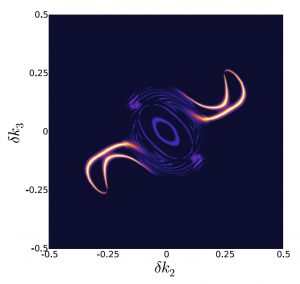
By Staff
An international team of researchers has predicted the existence of several previously unknown types of quantum particles in materials. The particles — which belong to the class of particles known as fermions — can be distinguished by several intrinsic properties, such as their responses to applied magnetic and electric fields. In several cases, fermions in the interior of the material show their presence on the surface via the appearance of electron states called Fermi arcs, which link the different types of fermion states in the material’s bulk.
The research, published online this week in the journal Science, was conducted by a team at Princeton University in collaboration with researchers at the Donostia International Physics Center (DIPC) in Spain and the Max Planck Institute for Chemical Physics of Solids in Germany. The investigators propose that many of the materials hosting the new types of fermions are “protected metals,” which are metals that do not allow, in most circumstances, an insulating state to develop. This research represents the newest avenue in the physics of “topological materials,” an area of science that has already fundamentally changed the way researchers see and interpret states of matter.
The team at Princeton included Barry Bradlyn and Jennifer Cano, both associate research scholars at the Princeton Center for Theoretical Science; Zhijun Wang, a postdoctoral research associate in the Department of Physics, Robert Cava, the Russell Wellman Moore Professor of Chemistry; and B. Andrei Bernevig, associate professor of physics. The research team also included Maia Vergniory, a postdoctoral research fellow at DIPC, and Claudia Felser, a professor of physics and chemistry and director of the Max Planck Institute for Chemical Physics of Solids.
For the past century, gapless fermions, which are quantum particles with no energy gap between their highest filled and lowest unfilled states, were thought to come in three varieties: Dirac, Majorana and Weyl. Condensed matter physics, which pioneers the study of quantum phases of matter, has become fertile ground for the discovery of these fermions in different materials through experiments conducted in crystals. These experiments enable researchers to explore exotic particles using relatively inexpensive laboratory equipment rather than large particle accelerators.
In the past four years, all three varieties of gapless fermions have been theoretically predicted and experimentally observed in different types of crystalline materials grown in laboratories around the world. The Weyl fermion was thought to be last of the group of predicted quasiparticles in nature. Research published earlier this year in the journal Nature (Wang et al., doi:10.1038/nature17410) has shown, however, that this is not the case, with the discovery of a bulk insulator which hosts an exotic surface fermion.
In the current paper, the team predicted and classified the possible exotic fermions that can appear in the bulk of materials. The energy of these fermions can be characterized as a function of their momentum into so-called energy bands, or branches. Unlike the Weyl and Dirac fermions, which, roughly speaking, exhibit an energy spectrum with 2- and 4-fold branches of allowed energy states, the new fermions can exhibit 3-, 6- and 8-fold branches. The 3-, 6-, or 8-fold branches meet up at points – called degeneracy points – in the Brillouin zone, which is the parameter space where the fermion momentum takes its values.
“Symmetries are essential to keep the fermions well-defined, as well as to uncover their physical properties,” Bradlyn said. “Locally, by inspecting the physics close to the degeneracy points, one can think of them as new particles, but this is only part of the story,” he said.
Cano added, “The new fermions know about the global topology of the material. Crucially, they connect to other points in the Brillouin zone in nontrivial ways.”
During the search for materials exhibiting the new fermions, the team uncovered a fundamentally new and systematic way of finding metals in nature. Until now, searching for metals involved performing detailed calculations of the electronic states of matter.
“The presence of the new fermions allows for a much easier way to determine whether a given system is a protected metal or not, in some cases without the need to do a detailed calculation,” Wang said.
Verginory added, “One can just count the number of electrons of a crystal, and figure out, based on symmetry, if a new fermion exists within observable range.”
The researchers suggest that this is because the new fermions require multiple electronic states to meet in energy: The 8-branch fermion requires the presence of 8 electronic states. As such, a system with only 4 electrons can only occupy half of those states and cannot be insulating, thereby creating a protected metal.
“The interplay between symmetry, topology and material science hinted by the presence of the new fermions is likely to play a more fundamental role in our future understanding of topological materials – both semimetals and insulators,” Cava said.
Felser added, “We all envision a future for quantum physical chemistry where one can write down the formula of a material, look at both the symmetries of the crystal lattice and at the valence orbitals of each element, and, without a calculation, be able to tell whether the material is a topological insulator or a protected metal.”
Funding for this study was provided by the US Army Research Office Multidisciplinary University Research Initiative, the US Office of Naval Research, the National Science Foundation, the David and Lucile Packard Foundation, the W. M. Keck Foundation, and the Spanish Ministry of Economy and Competitiveness.

You must be logged in to post a comment.